German camo helmet
Showing 7861–7920 of 17124 results
-
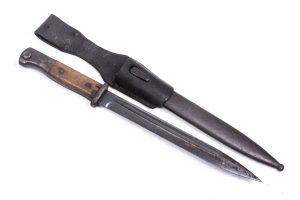
Matching K98 bayonet WKC 1937
Typical pre war K98 bayonet in used condition. Matching, unsharpened example dated 1937.
-
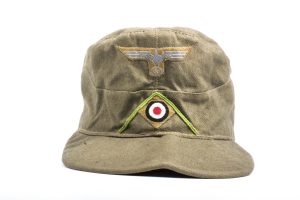
Perfect Heer Panzergrenadier EM M40 tropical cap marked Carl Halfar 1940
Excellent and impossible to upgrade heer M40 tropical field cap marked Carl Halfar 1940. The cap retains its factory sewn insignia original to the cap, the application is typical for this maker. The cap is nicely marked Carl Halfar 1940 in the size 55. The cap is constructed exactly how it should for this maker. This is one of the rarer and most desirable caps, in the most desirable condition and green Waffenfarbe for Panzergrenadiere. The cap has a period applied leather sweatband marked C. Pose Wehrausrustungen 1940. The cap was probably issued, never worn and or sent home immediately. This is the best tropical field cap I’ve ever had the pleasure to offer, a must have for any Afrikakorps collector
-
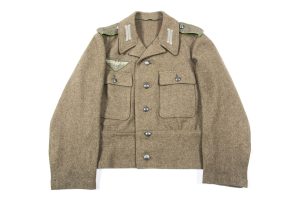
Heer M44 EM Field blouse with printed breast eagle
Rare, late war Heer EM M44 field blouse in the late war brown wool with printed breast eagle. The garment is in mint, unissued condition and comes with a beautiful pair of M43 pattern Panzergrenadier shoulder straps. Rare, late war garment that would be very hard to upgrade.
-
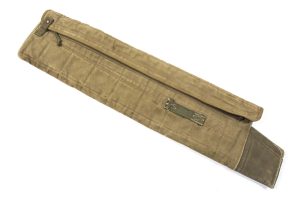
Modified US Paratrooper Griswold bag
Textbook original US paratrooper Griswold bag with period rigger added leg straps. The strap with the hook is resewn! The bag retains its working Talon zipper. A very rare and desirable Airborne item in very good condition.
-
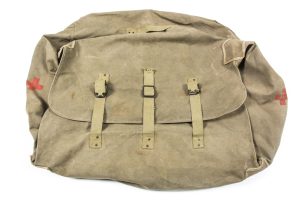
US Blanket set, Large
Rare original US Army Medical Department blanket set, Large.
-

Metal Druck-Zünder-35 box
Metal 1938 dated fuze box for Druck-Zünder-35. The label is loose inside otherwise it is in perfect condition. I found this box in the corner of a big barn in the Netherlands.
-
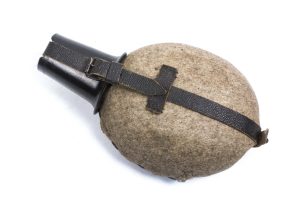
Unissued M31 canteen marked EEF43
Excellent textbook late war M31 (Feldflasche) canteen with aluminium flask in stone mint unissued condition. The flask and the felt cover are both nicely marked EEF 41 which indicates production by Ewald Eigenbrod Aluminium-und Metallwarenfabrik, Freiling in 1943. In textbook configuration with an excellent black urea resin (type of bakelite) cup marked 46/K which is usual for this manufacturer. Excellent matching canteen in excellent and impossible to upgrade condition!
-
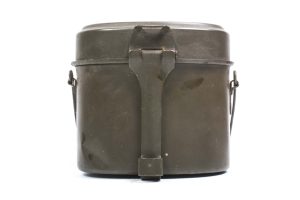
M42 messkit marked WJ43
M42 messkit marked WJ43 with over 90% of its factory paint remaining. Some small dents but otherwise perfect!
-
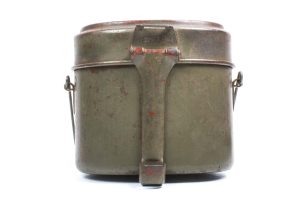
M42 messkit marked ZPSTZ 43
Beautiful steel M42 messkit marked ZPStZ 43 indicating production by Zieh, Press u. Stanzwerk, Schwarz & Co., Zwintschona-Halle in 1943.
-
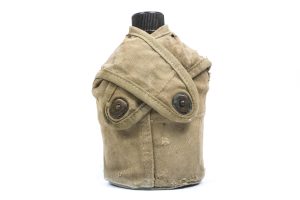
USMC first pattern cross flap canteen
USMC first pattern cross flap canteen with 1943 flask. One of the male lift the dot snaps is loose but present. Displays nicely!
-
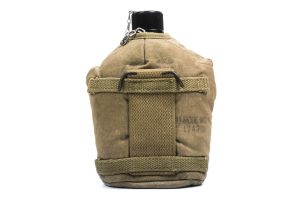
US Mounted canteen
US Mounted canteen with JA Shoe 1943 marked carrier, and 1943 dated flask and cup.
-
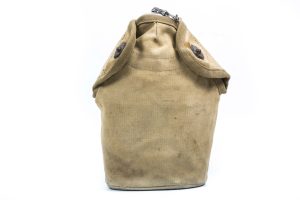
USMC second pattern canteen
Textbook USMC second pattern canteen with 1942 dated flask.
-
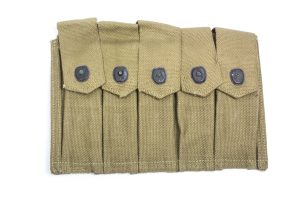
Thompson 5-cell magazine pouch General shoe corp. 1943
Thompson 5-cell magazine pouch marked General shoe corp. 1943
-

USMC helmet cover named Joe
Excellent combat used second pattern USMC M1 helmet camouflage cover named Joe. Nice salty example with vivid colours and loads of character!
-
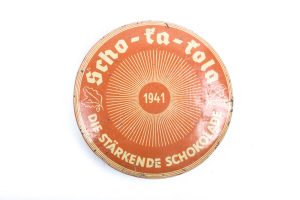
Wehrmacht issue chocolate Scho-Ka-Kola ration with content
Textbook Wehrmacht issue chocolate Scho-Ka-Kola ration. This caffeine laced issue chocolate was issued to troops serving on the front. Nicely dated 1941 and still with the original contents, hard to find in good condition.
-
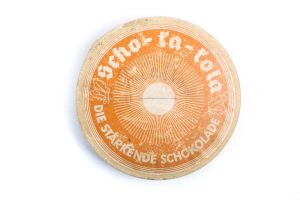
Rare cardboard Scho-Ka-Kola ration chocolate package
Rare original army issue cardboard Scho-Ka-Kola ration chocolate packaging in good used condition. Whilst most of these are made in metal; this is a rare 1942 dated variant executed in cardboard.
-
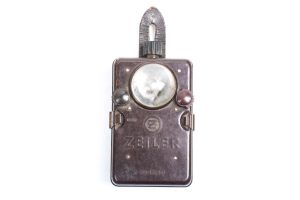
Brown bakelite Zeiler 4640 torch
Beautiful brown bakelite Zeiler 4640 torch in very good condition with Presstoff strap on the back. There is one small crack in the top left corner; otherwise it is near mint.
-

Brown bakelite Zeiler 4350 torch
Beautiful brown bakelite Zeiler 4350 torch in undamaged condition.
-
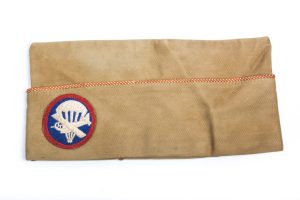
US overseas cap Signals with combined parachute and glider infantry patch
Textbook US overseas cap for a EM/NCO in a airborne unit. The cap is in excellent, worn condition. The cap retains piping for the Signal corps and a combined paratrooper and glider infantry patch.
-

Small German pocket agenda 1943
Typical small pocket agenda as used by many German soldiers for the year 1943 with many interesting notes.
-
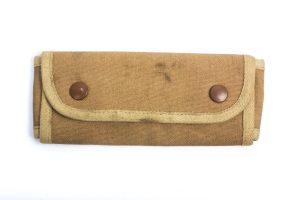
US Medical kit
Early, probably first world war issue US medical kit in good condition.
-
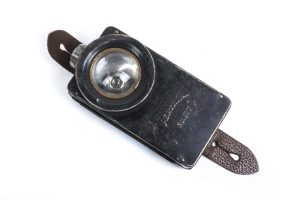
Petrix 677 torch
Textbook Petrix 677 torch in very good condition.
-

Gebirgsjäger rucksack strap connectors
Nice original set of Gebirgsjäger carrying strap connectors. These are virtually missing from most if not all Gebirgsjägerrucksacks and connect the carrying straps to the ammunition pouches.
-
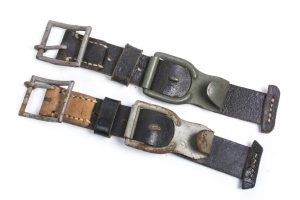
Gebirgsjäger rucksack strap connectors
Nice original set of Gebirgsjäger carrying strap connectors. These are virtually missing from most if not all Gebirgsjägerrucksacks and connect the carrying straps to the ammunition pouches.
-

Gebirgsjäger rucksack strap connectors
Nice original set of Gebirgsjäger carrying strap connectors. These are virtually missing from most if not all Gebirgsjägerrucksacks and connect the carrying straps to the ammunition pouches.
-
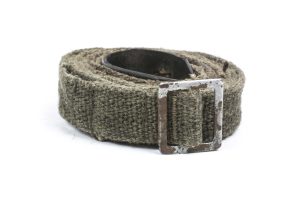
Long gasmask strap marked ebd44
Textbook late war gasmask strap in unissued condition marked ebd43. Sought after variant with rubber end piece.
-

US TM 8-260 Technical Manual Fixed Hospitals of the Medical department 1941
US TM 8-260Technical Manual Fixed Hospitals of the Medical department 1941.
-

A card of 24 Blaugrau uniform buttons
Original “Blaugrau” buttons for Heer, Luftwaffe and SS. In 1943 a new “einheitsfarbe” meaning colour for all branches was introduced and used on all garments. This was never fully implemented but a large portion of the M43 and most if not all M44 tunics received these. From that date onwards “Graublau” was the new textbook colour for pebbled buttons on uniforms. These can be seen on original m42, m43 and m44 tunics, mantels and caps. Also the M43 tropical uniforms and Fliegerblusen featured these. I have 4 perfect cards, the price is naturally for one.
-
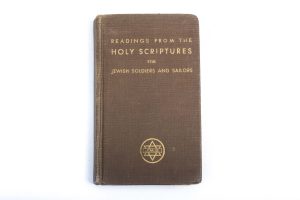
Readings from the Holy scriptures for Jewish soldiers and sailors
€75.00US Readings from the Holy scriptures for Jewish soldiers and sailors as issued to Jewish US WWII soldiers. Nicely dated 1942 and in very good unissued condition.
-

M38 Gasmask
Textbook canvas M38 gasmask in good used condition.
-

Rare late war wire RG34 cleaning chain
Rare late war wire cleaning chain in very good condition. This fully steel chain is the last model given out with the RG34 or Reinigungsgerät 34. This steel wire type cleaning chain is textbook for the late ware tan coloured RG34 kits!
-
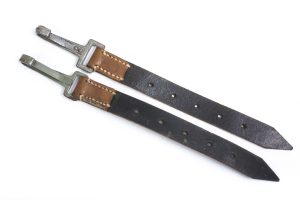
Gebirgsjäger rucksack connector straps
Gebirgsjäger connector straps in good, unissued condition.
-

Vintage 1930’s sunglasses
Hard to find mannequin accessory in good usable condition. The sunglasses are fully foldable with leather bridge.
-
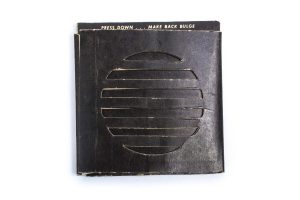
US Navy morse code trainer
€85.00Rare and unusual US navy morse code trainer in very good condition. Nicely marked USN Bureau of Naval Personnel – Training Aids.
-
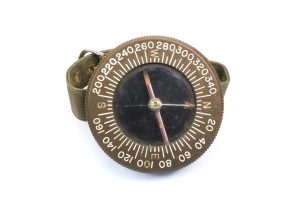
US Superior Magneto paratrooper wrist compass
Very nice US paratrooper wrist compass by Superior Magneto. Nicely dated and marked. These compasses where also known to been worn over the sleeve, the shoulder loops, webbing, or at the ankle over the jump boots. Wrist compasses were used both by officers and enlisted men. The strap is not the normal leather type but a period piece which came from an Elgin watch. A very nice example that would be hard to upgrade.
-

G43 magazine pouch marked ros 1944
Nice unissued K43 or G43 magazine pouch marked ros 1944indicating production by E. G. Leuner, Bautzen. The pouch is manufactured out of smooth brown leather with repurposed/reworked black leather belt loop which still retain button attachment holes. and is a very nice unissued example.
-
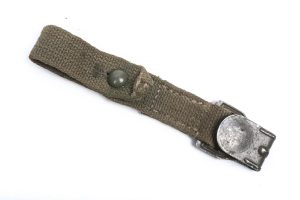
Early short adjustable gasmask strap
Nice short strap which was intended to attach the gasmask canister to the belt. Typical early/pre war example with 3 holes so the strap is adjustable in size and aluminium hardware.
-
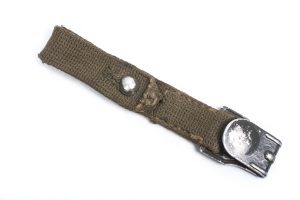
Early short adjustable gasmask strap
Nice short strap which was intended to attach the gasmask canister to the belt. Typical early/pre war example with 3 holes so the strap is adjustable in size and aluminium hardware.
-
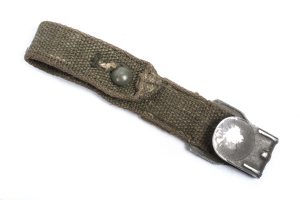
Early short adjustable gasmask strap
Nice short strap which was intended to attach the gasmask canister to the belt. Typical early/pre war example with 3 holes so the strap is adjustable in size and aluminium hardware.
-
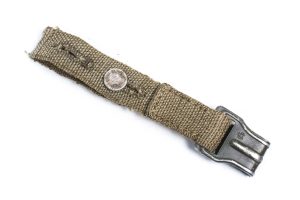
Early short adjustable gasmask strap
Nice short strap which was intended to attach the gasmask canister to the belt. Typical early/pre war example with 3 holes so the strap is adjustable in size and aluminium hardware.
-
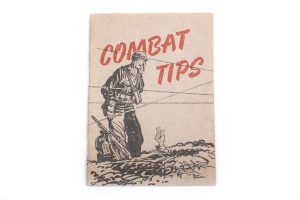
Combat Tips by Bill mauldin
Combat Tips Bill mauldin is a booklet containing the experiences of combat veterans. This booklet was distributed to the replacements later in the war without combat experience. Interesting booklet!
-

Mint US Pilot wing on paper card by Amcraft
Mint, unissued Pilot wings marked Amcraft. Rare to find it on the original factory paper card!
-
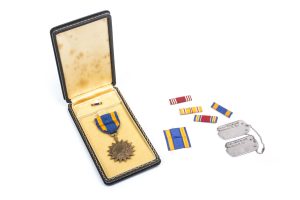
US ID’ed Air Medal grouping with dogtags to Thomas J.E. Brown Srgt. AAF
Named Air Medal with dogtags grouping to Thomas J.E. Brown Sergeant AAF. The grouping is in good condition and would be a nice base for further research.
-

US army rough out boots
Textbook US army issue rough out marked boots Holland Racine shoes inc. Dated Sept 30 1943. The boots are in good unissued condition with a small damage to the upper eyelet. Otherwise they are mint. Hard to find matching pair!
-

US Navy N1 field shoes Boondockers February 1944
US navy N1 field shoes Boondockers. The shoes are nicely marked A. Freedman & Sons Inc. and dated 24 February 1944. The shoes are size 12 A (European size 44-46). Nicely named to C.F. Hennessy. Rare US navy N1 Boondockers in near mint condition!
-
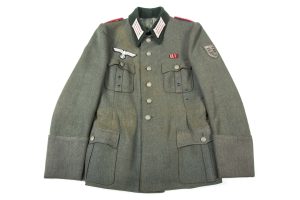
Heer Panzer tunic for a Leutnant der Panzerjäger
Stunning original Heer tunic for a Leutnant der Panzerjäger. The garment would be a stunning base for a award display with many award loops on the left ánd right breast pocket. The right breast pocket indicates it was once adorned with a DKIG or Deutsches Kreuz in Gold. The collar tabs and shoulder boards are original to the tunic and show the cypher for the Panzerjäger. There is a slight discouloring which shows more in the photographs then in real life, IMO it wouldn’t be that bad in a display setting. Very hard to find Panzer officers tunic with many award loops – perfect for a award display!
-
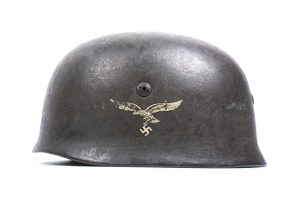
Superb early single decal M38 paratrooper helmet
A superb(!) example of the first type M38 paratrooper helmet to follow the pre war double decal model in 1940. First issued in 1940 it still has the early aluminum liner and a low lot number 719. A size 68 shell by by Eisen- u. Huettenwerke, Thale, Harz. The helmet has a size 68 shell and a large size 58 liner. The liner is the early aluminum type with light grey padding material. The helmet retains all 4 of its original early type vented bolts and their nuts. This is probably one of the first helmets to be finished in feldgrau with a single decal in 1940. Surely one of the best M38 paratrooper helmets we’ve ever had on offer!
-
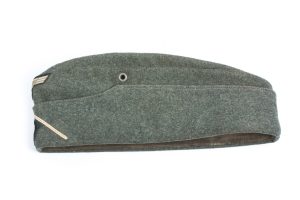
Excellent Heer Infanterie sidecap marked Infanterie Regiment 16
Untouched Heer M34 sidecap or Schiffschen with white soutache for Infanterie. Nicely marked J.R.16 for Infanterie Regiment 16. Nice with typical pre war grey backed factory hand sewn bevo insignia and machine sewn white soutache for Infanterie. The cap is a good large size 58. On top of it all it has a nice unit marking to Infanterie Regiment 16, which was a air landing unit during the 1940 campaign in Rotterdam. A excellent and rare cap in top condition!
-
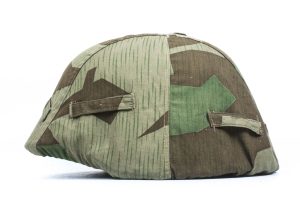
Splittertarn helmet cover marked PC SS 03208
A textbook and minty original German Heer helmet cover in Splittertarn or splinter camouflage. The cover is photographed on a size 66 shell. The cover is in absolute mint condition and shows no signs of use. Rarer then SS helmet covers!
-
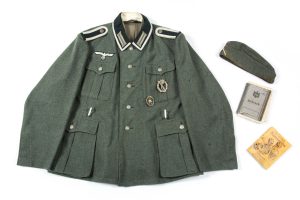
Heer M36 field blouse with sidecap grouping to Uffz. Karl Adolf Glüth I.R.18
Beautiful M36 field blouse grouping to Karl Adolf Glüth complete with sidecap, Wehrpass, documents and Harmonica manual. The group was recently found in household clearing in Germany and as far as I know has not been in a single collection before. The jacket is a textbook, non modified M36 field blouse dated 1939. The garment is in a good, large size with period sewn insignia. The left breast pocket is addorned with two sets of award loops with their original Infanteriesturmabzeichen (Schuco 41) and its unmarked Verwundetenabzeichen in Schwarz. The shoulderstraps are matching and nice early example with stonegrey backing material and tongues. The kragenlitzen are mounted, infantry examples. The garment retains 3 belt hooks and its Kragenbinde. The sidecap is in salty but untouched condition with period sewn insignia.
The Wehrpass has a number of interesting notes about Glüth; his family, awards, place of birth etcetera. Glüth enlisted in 1937 in Infanterie Regiment 18 which he served until his death 27.10.1942. He was trained with the 98K, MG34, P08 Luger, Lei.Gr.W. 36, Panzerbüchse 38, MP28 and MP38. He was promoted to Oberschützen 1.11.38, Gefreiter 1.12.38 and Unteroffizier 1.11.39. He was awarded the Infanterie Sturmabzeichen in Silber 2.7.41, the Eisernez Kreuz II klasse 22.2.42, the Verwundetenabzeichen in Schwarz 22.2.42 and the Ostmedaille 4.8.42.
I have literally translated the most interesting battles noted in his Wehrpass. The war began for Glüth on 17.9.39 fighting at the Rhein, 18.10.39 at Saar, Kornbach. 9.5.40 he broke through to the Ärmelkanal, 15.5.40 the push to through Belgium to France, 21.5.40 fighting at the Somme, 5.6.40 second battle for France, 6.6.40 crossing the Somme, 8.6.40 following battles from the Somme to the Seine, 12.6.40 battle at the Seine, 19.6.40 battles south of the Seine and movement to the Loire, 20.6.40 crossing the Loire, 26.6.40 occupation of France. 3.9.40 he was moved to Coastal guard at the Atlantikküste. 25.3.41 he guarded the Kanalküste. 22.6.41 the battle from Bialystock and Minsk, 8.7.41 battle at Smolensk, 26.7.41 defensive battles at the Düna and Smolensk. 2.10.41 the double battle at Wjasma and Brjansk, breakthrough at the Dnepr positions. 4.10.41 the move to Moscow, Woronesj and Kalinin.
A great and interesting uniform grouping with loads of possibilities for further research!
-
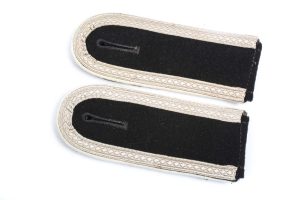
Waffen-SS shoulderstraps for a Unterscharführer der Infanterie
Matching early pair of Waffen-SS NCO shoulderstraps for a Unterscharführer der Infanterie. The shoulderstraps are well executed and show the textbook construction one would expect. The straps are in very good condition and would easily match to a minty tunic or overcoat. The straps feature the early silver tresse. These straps are the lowest NCO rank for sure seeing lots of action on the front line. A very nice matching pair that is highly sought after and only scarcely encountered nowadays!
-
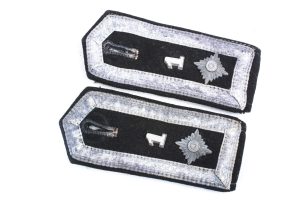
Rare Waffen-SS shoulderstraps SS-Oberscharfuhrer in ‘Deutschland’
Rare original SS-Verfügungstruppen 1 ‘ Deutschland ‘ shoulderstraps for a SS-Oberscharführer. Rare, matching pair in good worn condition.
-

ET66 M35 double decal field repainted helmet
Beautiful Heer double decal M35 helmet marked ET66 indicating production by Eisenhuttenwerke Thale. The helmet features its factory installed liner and period placed chinstrap. The helmet retains both decals with the eagle decal nicely masked prior to painting. The tricolor can be seen peaking through the rough overpaint. The helmet is a excellent and textbook example of a early overpaint!
-

Crushed Heer EM Artillerie visor for Artillerie Regiment 106
Beautifully crushed Heer EM / NCO visor with the unit marking for (Grenz-)Artillerie-Regiment 106. This heavy artillery unit was founded in Zweibrücken in 1938. The visor is in good, worn condition with original insignia. The cap is a good medium size. The sweatband and its visor were reinforced at some point with hand stitches. Otherwise a great visor!
-
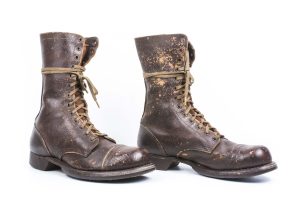
US Corcoran paratrooper jump boots by Cat’s-Paw
Excellent pair of world war two issued US Corcoran paratrooper jump boots. The boots are made by manufacturer Cat’s-Paw and have a lots of wear which give these boots a nice amount of character!
-
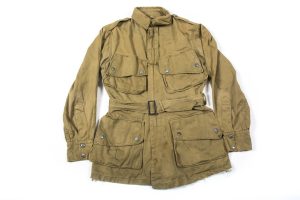
US M1942 Coat, Parachute, Jumper
Textbook US M1942 jumpsuit in combat worn condition. The jacket has a partial laundry number or name in the neck making it a base for further research. The jacket retains its working zippers and its sewn in waist belt. Excellent paratrooper garment in typical combat worn condition with the right amount of character!
-
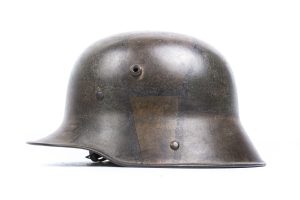
Q66 M16 geometrical camouflage helmet
Excellent first world war M16 helmet with period applied geometrical camouflage pattern often referred to as Mimikri. The helmet retains up to 90% of its original finish and its original liner and chinstrap. The helmet is a nice large size 66. A very nice helmet that would be very hard to upgrade!
-
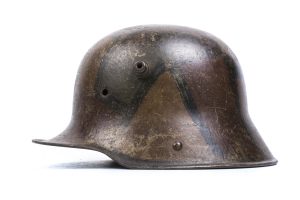
BF62 M16 geometrical camouflage helmet
Excellent first world war M16 helmet with period applied geometrical camouflage pattern often referred to as Mimikri. The helmet retains up to 90% of its original finish and its original liner and chinstrap. The helmet is a size 62. A very nice helmet that would be very hard to upgrade!
-
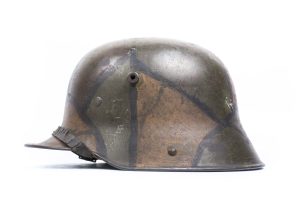
Si66 M16 geometrical camouflage helmet
Excellent first world war M16 helmet with period applied geometrical camouflage pattern often referred to as Mimikri. The helmet retains up to 90% of its original finish and its original liner and chinstrap. The helmet is a nice large size 66. A very nice helmet that would be very hard to upgrade!
-
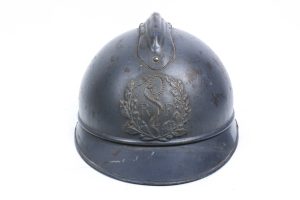
Rare French M1915 medical Adrian helmet
Rare French M1915 Adrian helmet with period affixed insignia for medical. The Medicine of this Adrian range of helmets is one of the rarest branches to find!
Showing 7861–7920 of 17124 results


